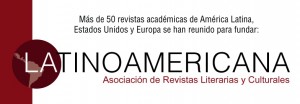César Aira, the teller machine. A reading of Ema the captive
Abstract
One of the recurring themes in Argentine literature is the tense relationship of man with the desert and its laws. From the first chroniclers to the romantic writers, the dialectic of the subject and the space was problematized discursively by innumerable authors. Under that perspective and debtor of that tradition, César Aira breaks into the national scene with one of his first works to question and honor the nineteenth-century literary tradition. The following article analyzes the novel Ema la cautiva (1981) in relation to the imaginaries of power that deconstruct the vision of the desert, the captives, the Indians. We will try to point out the discursive mechanisms used by the author to achieve a novel and irreverent view of the Argentine literary tradition of the 19th century.
References
Aira, César (1993). “Artl” en Paradoxa 7. Rosario: Beatriz Viterbo Editora.
---------- (2005). Ema la cautiva. Mérida: el otro el mismo Ediciones.
Contreras, Sandra (2005). “Prólogo” a Ema la cautiva. Mérida: el otro el mismo Edicio- nes.
---------- (2015). “Aira con Borges”. Biblioteca Nacional Argentina “Mariano Moreno”; La Biblioteca; 13; -1-2013; 184-198.
Diccionario de la Real Academia (2018), recuperado de: https://dle.rae.es/ ?w=diccionario
Fernández, Nancy (1996). “Bordes, límites y fronteras: notas sobre los viajes en Mansilla, Saer y Aira” en Letras, Curitiba no45, Editora da UFPR.
---------- (2012). “César Aira, el punto de inicio” en Mónica Bueno (comp.) La novela argentina: Experiencia y tradición. Buenos Aires: Corregidor.
Laera, Alejandra (2014). “Introducción” en Ficciones del dinero. Argentina, 1890-2001, Buenos Aires: Fondo de Cultura Económica.
Pérez Calarco, Martín (2015). “Inscripciones contemporáneas de la matriz gauchesca. Moreira y la revolución cultural de los 60’-70’, de César Aira a Néstor Perlongher” en Edgardo Berg y Nancy Fernández (coord. y ed.) Intervenciones. Mar del Plata: La Bola Editora.
Piglia, Ricardo (2000). Crítica y ficción. Buenos Aires: Seix Barral.
Rotker, Susana (1999). “Noticias de un mundo que se acaba. Una excursión a los indios Ranqueles de Lucio V. Mansilla” en Cautivas. Olvidos y memoria en la Argentina. Buenos Aires: Arial.
Copyright (c) 2019 Revista Telar ISSN 1668-3633

This work is licensed under a Creative Commons Attribution-NonCommercial-ShareAlike 4.0 International License.
La aceptación de colaboraciones por parte de la revista implica la cesión no exclusiva de los derechos patrimoniales de los autores a favor del editor, quien permite la reutilización, luego de su edición en papel (postprint), bajo licencia Creative Commons Atribución-NoComercial-CompartirIgual 3.0
La cesión de derechos no exclusivos implica también la autorización por parte de los autores para que el trabajo sea alojado en el repositorio institucional de la UNT y difundido a través de las bases de datos que el editor considere apropiadas para su indización, con miras a incrementar la visibilidad de la revista y sus autores.























